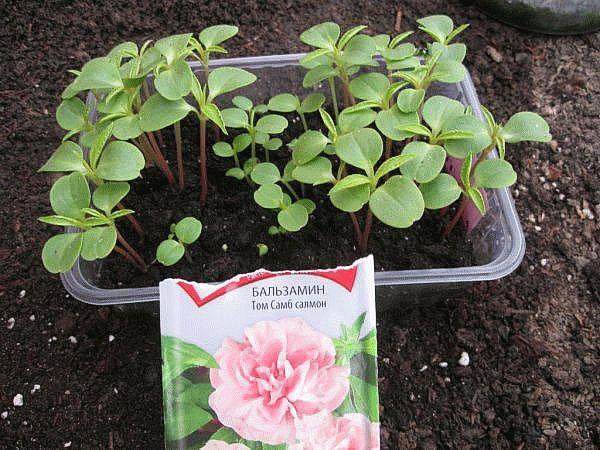Growing balsam seedlings
 Balsam is indoor and garden... Growing adult flowers of indoor varieties and caring for garden varieties is different. Despite the different growing conditions for adult balsam flowers, their seedlings are grown in the same way. To obtain high-quality planting material, you need to prepare balsam seeds, select a suitable soil composition, and also increase the light day of the sprouts and fertilize the soil.
Balsam is indoor and garden... Growing adult flowers of indoor varieties and caring for garden varieties is different. Despite the different growing conditions for adult balsam flowers, their seedlings are grown in the same way. To obtain high-quality planting material, you need to prepare balsam seeds, select a suitable soil composition, and also increase the light day of the sprouts and fertilize the soil.
Preparation of balsam seeds
Balsam seeds must be soaked in a slightly pink solution of potassium permanganate.
The seeds are placed in a warm solution for half an hour. It is impossible to overexpose balsam seeds in solution, otherwise they will not be suitable for planting. Since the balsam seeds are very small, it is better to strain the solution with the seeds through a sieve.
After the seeds are treated with a solution of potassium permanganate, they are planted in a common container with loose fertile soil. In such a container, balsam is germinated. Sowing the seed must be done no later than March 10th, as it sprouts very slowly and unevenly.
Transplanting seedlings into separate cassettes
Do not worry about the fact that the balsam rises unevenly. This is convenient for transplanting seedlings into separate cassettes. When the balsam seedling forms two seven-lobed leaves, it is transplanted. By this time, the root system of the seedling deepens into the soil by 3-5 cm. The plant is carefully dug out of the common container with a garden trowel, and then transplanted into a new separate container, trying not to injure the root system. The seedling is buried in the soil up to seven-lobed leaves.
It is necessary to moisten the soil immediately after transplanting with a spray bottle. In order for the seedlings to grow a powerful aerial part, the daylight hours of the balsam are increased to 12-15 hours. Balsam can stretch out due to lack of light. Such a plant will not bloom profusely.
Transplanting seedlings into open ground
In open ground, balsam seedlings are planted in mid-May, when frosts are no longer expected. One liter of water is poured into the hole and, without waiting for the soil to dry out, balsam seedlings are planted. The hole is covered with fertile soil. It is not necessary to water the balsam after transplanting. If you plant balsam in the warm season, it will bloom in early June. During flowering, balsam must be fed potash fertilizers, and cut watering.